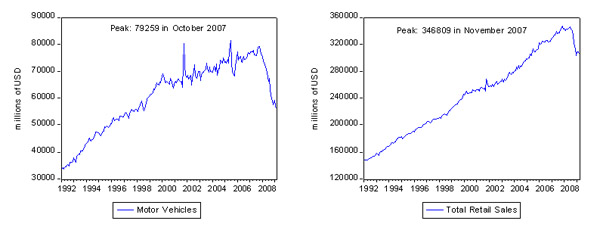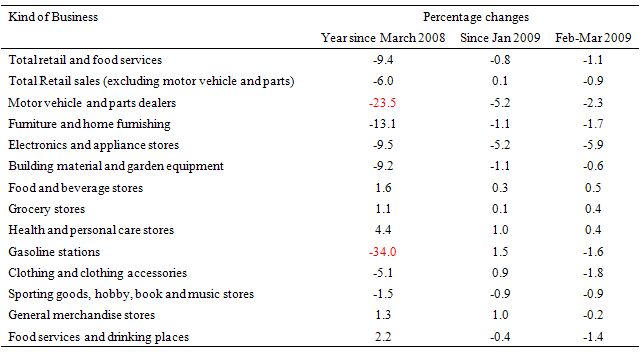I started my undergraduate studies in economics in the late 1970s after starting out as…
The green shoots of recovery … been looking!
In the last few weeks gardening has entered the macroeconomic discourse again. All over the place – apparently – little green shoots are emerging which bode well for the future. But are there any actual signs? Recent data releases from the US and today’s Index of Economic Activity in Australia suggest that the green shoots are still somewhat subterrainean in inclination. The latest data confirms the message that last week’s Labour Force data sent very loudly – the product and labour markets are now starting to align in a very ugly way and much more fertiliser (organic) is needed in the form of government stimulus …. sorry to repeat it, but, preferably in the form of direct job creation.

It is always a legitimate function of our leaders to build confidence in the economy and to reassure those who are losing jobs and their homes that things will be better in the near future. It is also clear that the huge fiscal injections that are going into economies around the world will eventually stop the rot. Certainly the automatic stablisers built into the budget (lost tax revenue and increased welfare support) will help turn the spending gap around.
Both the US President and the US Fed Reserve Chairman have been talking up the US economy in the last week. That is before they latest retail sales data came out. The confidence-boosting talk came after the latest Bureau of Labor Statistics data showed that the US labour market was still deteriorating fast (non-farm employment fell by 660,000 in the last month alone).
In the UK, the Government Business minister Baroness Vadera has been accused of being “out of touch after claiming she could see a few green shoots of economic recovery.” This is at the same time as the UK Government has now revised its GDP forecasts down for 2009 to show a (amazing) 3 per cent contraction. The Chancellor of the Exchequer admitted recently that the economic slump afflicting Britain is now much worse than previously estimated.
In the Guardian earlier in the week there was a nice article about how these green shoots are are looking very pale green at best!. The article says in relation to US Fed Reserve Chairman Bernanke’s comments that he could see green shoots in some places:
Some commentators believe Bernanke’s statement proves nothing other than he needs his eyes testing, or that he is doing his best to talk up the economy and lift the mood of the nation. But there are others who believe that if the shoots aren’t visible now, they soon will be as a result of the sheer scale of the economic stimulus package … So far, however, the evidence is patchy …
Last week on the ABCs 7.30 Report, ANU economics professor Warwick McKibbon (who is also a conservative government appointment on the RBA board) said he could also see green shoots of recovery. He must have heard the US President or someone else who is important say this and thought it sounded good. As an aside, his analysis on Japan was difficult to accept but that is another story. Anyway, he told the 7.30 Report that “If you just look at the statistics you can see that the US by now should be starting to come out of the dynamic adjusted path of recession.” That’s economic talk for nothing. He also said China was starting to come out of the slump which is still a matter of contention. Some commentators are saying it will get worse in China before it gets better. But it is true. The Chinese government has introduced a massive fiscal stimulus which will eventually work as it will elsewhere.
But all this green optimism in recent days made me go in search of hard data to see whether things are starting to grow. I summarise just a bit of this data in this blog.
The Euro zone still is in bleak shape. Recent estimates of GDP growth for zone for the fourth quarter of 2008 have now been revised down to – 1.6 per cent. Further Morgan Stanley, the US investment bank, has recently said that “due to a run of very disappointing activity indicators, it was aggressively lowering its 2009 GDP growth estimates for the Eurozone. It cut the 2009 GDP growth estimate for the Eurozone to -3.3%, from -1.6% before. This would imply a contraction in activity that is considerably larger than any experienced since the end of World War II in 1945.” So they are not expecting growth anytime soon.
I had a look at the latest retail sales data for the US today out of curiosity – in search of some green shoots. The latest US retail sales data do not provide much cause for optimism? The following graph shows motor vehicles and parts (left hand panel in millions of USD) and total retail sales (right hand panel in millions of USD). The downturn since late 2007 is the sort of incline that surfers dream about!
The following table shows you in more detail what is currently happening to retail sales in the US. The data comes from the US Census Bureau, which is sort of like the Australian Bureau of Statistics (but not quite!). So motor cars and related products (fuel) have fallen off a cliff and remain that way in the early months of 2009. The old adage that when things get bleak it is best to be in the food and grog business appears to hold water. Also I am wondering what is driving the growth in Health and personal care stores. Maybe depression tablets!
In Australia the latest data out today also supports the “bad for green” story. The annual growth rate of the Westpac-Melbourne Institute Leading Index of economic activity has also fallen off a cliff to be -5.1 per cent in February. The expected long-term trend is 2.9 per cent. In historical terms, the new levels of the Index are below those estimated during the 1991 recession. In January the figure was -3.1 per cent.
There are two things economists look for in data: (a) the levels; and (b) the rates of change. From both perspectives, these results point to a very weak economy and one which is deteriorating faster than expected and faster than the deterioration during the 1991 recession. This starts to resemble the message in my blog last week on the labour force survey data. It is clear that the product and labour markets are now starting to align in a very ugly way.
So in the upcoming budget the Federal government is going to be forced to change direction I suspect. Much more fiscal stimulus is needed. It will also have to be applied in different ways. They will just have to choke on their neo-liberal sandwiches and start showing some fiscal leadership to stop unemployment from rising.
Anyway, as a parting message, for those that can see green shoots all over the place, maybe they have been lost here for a while!
Government budget statements
Regular commentator Lefty made the point in a comment on an earlier blog that the Australian Government budget statements were still pushing the line that they were wanting to get back into surplus.
In the Part 1: Overview of the Updated Economic and Fiscal Outlook for the 2008-09 Federal Budget, you read the following:
2. Return the budget to surplus: the fiscal strategy as the economy recovers
The Government reaffirms its commitment to achieve budget surpluses, on average, over the economic cycle. As the economy recovers, and grows above trend, the Government will take action to return the budget to surplus by:
* allowing the level of tax receipts to recover naturally as the economy improves, while maintaining the Government’s commitment to keep taxation as a share of GDP below the 2007-08 level on average; and
* holding real growth in spending to 2 per cent a year until the budget returns to surplus.
At face it must just be a political statement beause it has no economic sense attached to it. But, the worrying thing is that the Government and its neo-liberal advisors actually think it is a sensible economic commitment to make.
I am working on some simulations to explore this question in empirical terms. But the conceptual point that emerges from any understanding of the way the modern monetary system operates is that this is a nonsensical ambition. It is ridiculous because it is divorced from: (a) a statement about what the Government estimates the non-government sector saving desires will be over the same planning horizon; and (b) what level of unemployment (and broader labour underutilisation) the Government is aiming to choose!.
The first point is that if they truly want to aspire to achieve full employment, then the non-government sector chooses the size of the budget deficit not the Government. The Government has to fill the spending gap left by the savings desire of the non-government sector. There is no escaping that point. So if the non-government sector desires to save more (which it currently is big-time!) then the deficit will be larger. In that context, it makes no sense to set a target level of spending or deficit.
Second, the only way the government could attempt to fulfill these quantitative targets is to let the unemployment rate be whatever the private market delivers, which has been more or less the approach over the last 30 years and the results are obvious – high and persistent rates of labour underutilisation. But even if the government attempts to hold to some “budget rule” such as is announced here it will probably fail because private spending will fluctuate and the automatic stabilisers will then keep changing the budget outcome.
The reality is that it makes no sense at all to target a budget outcome. The correct outcome to target is a rate of unemployment and then spend up to that point. As things stand, if the Federal government tries to reduce spending over the next few years to work towards a surplus, it is likely to prolong the recession and make their job even harder.
Finally, as long as the non-government sector desires to save in $AUD then the Government has to run a deficit. Sorry to disappoint them.


The green shoots of recovery are looking withered and black here in Gladstone. Rio Tinto has announced that it will shed another 300-500 jobs by the end of the week. There won’t be anything left of my little town!
Digression: a poster on another blog raised the possibility of vast sums of money being electronically created by cyber-counterfitters and distributed as debt without governments, central banks, national tax offices or intelligence agencies being any the wiser. While this sounded implausable in the extreme to me, what mechanisms do national governments posess to prevent something like this occurring?
I should have added that the poster in question charges that this has heavily contributed to the GFC and the ensuing morbid effects that this post is discussing, so the question isn’t really a digression as such.
Dear Lefty
I am unsure how this type of credit would enter the system. In what form does it arise? Bank credits? If so, then nothing net would be created because the banks have a double entry system. Outside of government to non-government transactions all other transactions net to zero – every asset has an offsetting liability somewhere in the system. So without any more detail I cannot comment.
best wishes
bill
http://www.independent.co.uk/news/business/economic-veiw-internets-tangled-money-web-worries-central-banks-1330387.html
Apologies for niether being able to post a clickable link or cut and paste the article, as I have mentioned, my IT skills are very poor.
The developed world and Australia is saturated with DEBT. Australia has record levels of private DEBT which is ignored by mainstream economists eg Reserve Bank – Glen “Inflation Fighter” Stevens. Our governments’ reaction is to take on even more DEBT . You cannot solve a DEBT problem with even more DEBT. Green Shoots are for those who are still Green behing the ears. Don’t tell Ducky and Recesson 09. Let it be a surprise that no one saw coming.
Debt deflation,
Are you arguing that sovereign government debt is the same thing as private debt? They are not remotely the same thing. Read some more of Bill’s blog.